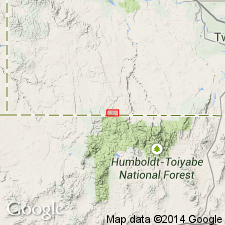
- Usage in publication:
-
- Cedar Canyon tuff
- Modifications:
-
- Named
- Dominant lithology:
-
- Tuff
- Rhyodacite
- AAPG geologic province:
-
- Snake River basin
Summary:
Named as second of three [unranked] units of Bieroth volcanics [rank of Bieroth not specified; not clear if formal or informal unit]. Named for side canyon which joins Bruneau a short distance downstream from McDonald Creek. Reference [type] locality at Bruneau Canyon near mouth of McDonald Creek in Elko Co, NV. Occurs in southeast and southwest part of mapped area (R5E at ID-NV border), south-central Owyhee Co, ID, as well as northern NV (not mapped), Snake River basin. Consists of light- to brownish-gray, moderately to strongly compacted, vitric-crystal, welded ash-flow tuff of rhyodacite composition. Consists of up to 3 flows; total thickness is at least 90 m. Probably overlies Alder Creek tuff (first used) (field relations not clear); intruded by volcanic neck of Browns Basin (uppermost of three units of Bieroth volcanics). Underlies various Miocene volcanic units. Geologic map. Chemical analyses. Eocene age based on correlation with similar units radiometrically dated in Jarbidge Mountains (40.9 m.y.; Coats, 1964) and in Poison Creek area of northern Owyhee Co (44.7 m.y.; Armstrong and others, 1980).
Source: GNU records (USGS DDS-6; Denver GNULEX).
For more information, please contact Nancy Stamm, Geologic Names Committee Secretary.
Asterisk (*) indicates published by U.S. Geological Survey authors.
"No current usage" (†) implies that a name has been abandoned or has fallen into disuse. Former usage and, if known, replacement name given in parentheses ( ).
Slash (/) indicates name conflicts with nomenclatural guidelines (CSN, 1933; ACSN, 1961, 1970; NACSN, 1983, 2005, 2021). May be explained within brackets ([ ]).

